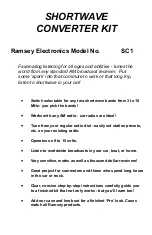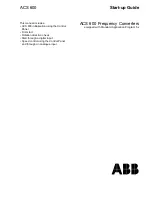
SC-1
•
8
CIRCUIT DESCRIPTION
Q3 functions as part of a variable Colpitts oscillator which utilizes S2 and
jumper points A,B,C to setup a choice of preferred local oscillator
frequencies from 3 to 22 MHz. L2 and C10 may be replaced by a crystal for
tuning in a desired range 500 to 1600 KHz around the crystal oscillator
frequency.
C2,C3 and L3,L4 and L5 form a high-pass filter from the antenna to pass
shortwave signals only and to minimize strong local AM broadcast signals.
The antenna-filter network and the Q3 oscillator output are fed to the base of
mixer-amplifier Q2. The transistor output is fed to the RF input of a standard
550-1600 KHz AM broadcast band receiver. The receiver can detect and
amplify shortwave signals on frequencies which are either the sum or the
difference of the SC-1 oscillator frequency and the dial setting of the
receiver.
Our directions for adjusting the SC-1 assume a pattern of the received
frequency being the SC-1 oscillator ADDED to the tuning range of the AM
radio. For example, to receive 10 MHz WWV, the radio dial is set to 1000
KHz, and the SC-1 oscillator is set to 9 MHz Another way of viewing it is that
if the oscillator is set to 9 MHz, the receiver will tune 9.550 to 10.600 MHz (9
MHz plus the 550-1600 AM radio range) depending on how much the radio's
tuning overlaps the standard 550 KHz to 1600 KHz broadcast band.
The antenna RF input filter is broad-banded. There is no provision for pre-
selecting any particular portion of the HF spectrum at either the input or
output of Q2. Therefore, occasional images from strong signal sources
should be anticipated. Generally, the reception of typical shortwave
broadcast stations fully overwhelms any image signal.
S1 serves two functions. In the "off" position, S1B connects the antenna jack
directly to the receiver jack, permitting normal AM broadcast reception. In the
"on" position, DC voltage is applied to the SC-1 circuitry and the antenna is
connected through the high-pass filter to Q2.
Q1 is connected with its emitter-base junction reverse biased, so that it
serves as a voltage regulator, limiting the voltage on its emitter to 7 volts and
enhancing the stability of the oscillator.






































